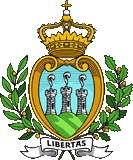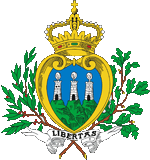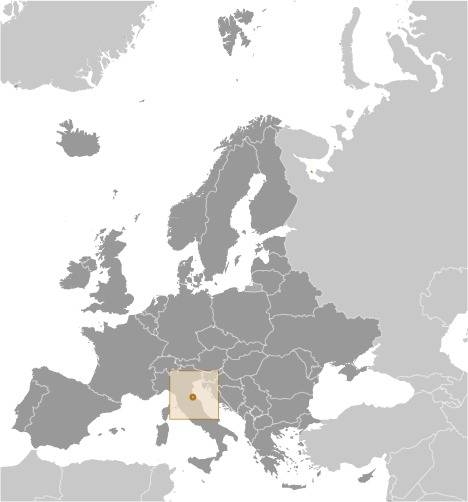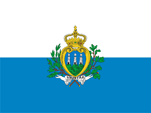
The flag of San Marino was last defined in its current form in 2011 with a law on the flag and the coat of arms. The previously valid law of 6th of April in 1862 regulated the coat of arms, but did not mention the flag. Thus, the light blue of the flag has been clearly defined since 2011, namely as Pantone 2915. The flag shows two horizontal stripes in white and light blue. The white stands for the snow on the Monte Titano and the clouds, the blue stands for the heaven. Already in 1797 – Napoléon had Italy even conquered – those two colours were choosen for the cockade and the flag of San Marino. As origin of the colours counts the coat of arms with its blue sky and the white towers. The state flag shows the coat of arms in the middle.
Source:
Wikipedia (EN), Volker Preuß


since 2011,
Coat of arms of San Marino,
Source: Zscout370, Public domain, via Wikimedia Commons

1862–2011,
Coat of arms of San Marino,
Source, by: Fry1989, Public domain, via Wikimedia Commons

The coat of arms of San Marino was last defined in its current form in 2011 with a law on the flag and the coat of arms. Until then, the law of 6th of April in 1862 was in force. The coat of arms has been known since the 14th century. It shows a heart-shaped bordered shield: in front of a blue sky three white towers – decorated with white ostrich feathers – on each one peaks of a green mountain. Above that a crown, to the left and on the right one laurel and one oak twig. Below a white banner with the inscription "Libertas" → "Freedom". The crown stands for the sovereignty of the people – San Marino was always a republic. The three towers stand for the three castles (Guaita, Cesta and Montale) on the three peaks of Monte Titano. They embody the ability of the country to put up a fight. The white ostrich feathers on the towers are called "pennae" (penna [lat.] = feather), a hint at the Apennin Mountains in which San Marino is situated.
Source:
Die Welt der Flaggen,
Flaggen Wappen Hymnen,
Flaggen und Coat of arms of the Welt,
Volker Preuß

Location:

Source: CIA World Factbook
Map of the country:

Source: CIA World Factbook

Area: 24 square miles
Inhabitants: 33.598 (2021), thereof 83% Sanmarinese, 12% Italians
Religions: 92% Roman Catholic
Density of Population: 1.427 inh./sq.mi.
Capital: San Marino (Città di San Marino), 4.056 inh. (2021)
official Language: Italian
other Languages: English, German, French, Romagnol
Currency: 1 Euro (EUR, €) = 100 Cent, Scudo
Time Zone: GMT + 1 h
Source:
Wikipedia (DE)

301 · the Dalmatian christ and stonecutter Marinus (Marino, Marinu), flees with other christs from the persecutions of christs onto the Titano Mountain (Monte Titano), development of a smallholding
400–410 · invasions of the Goth in Italy
440–460 · Vandal's invasions in Italy
476 · dismissal of the last Roman emperor Romulus Augustulus, end of the (West)Roman Empire, on the area of the today's Italy exists until 493 the Empire of the Odoaker
434–540 · capture by Byzantium (East Rome)
568–569 · capture of Italy by the Langobards
600 · the smallholding at the Monte Titano has with its constitution a republican character
800 · the smallholding subordinates itself the protection of the Counts of Montefeltro
885 · an Abbey "San Marino" (Holy Marinus) is documentary mentioned for the first time by the Bishop of Rimini
10th cent. · the smallholding of San Marino builds a wall
1249 · the protection of the Counts of Montefeltro ends (lineage probably extincted, county ended)
1253 · the democratic constitution of San Mariono becomes officially written down
1400 · San Marino subordinates itself the protection of the Dukes of Urbino, but it stands as an independent state
1443 · San Marino consist within the today’s borders
1599 · changes of constitution
1796–1797 · Italy campaign of Napoléon, San Marino renounces for an enlargement of its territory on the occasion of the reduction of the Vatican State, France recognizes San Marino as independent state
1815 · Vienna Congress, reconfiguration of Europe after the era Napoléon, the independence of San Marino becomes confirmed
1862 · customs union and treaty of protection with the Kingdom of Italy
1914–1918 · First World War, San Marino joines the Entente
1939 · changes of constitution
1939–1945 · Second World War, San Marino is initially neutral, but declares the war to the German Empire in 1944, because of that German troops occupied San Marino on 4th of September 1944, in January 1945 British troops occupied the country
1945–1957 · socialistic-communist government, expropriation of the bigest landowners, nationalize of economy
1957 · failed attempt of a coup d’état of the Capitani reggenti, but a civil coalition takes over the power
1959 · elections confirm the civil coalition
1968 · the treaty of protection with Italy ends
1978 · elections, again socialistic-communist government
1986 · overthrow of the socialistic-communist government
1992 · San Marino joines the UNO
Source:
Atlas zur Geschichte,
World Statesmen,
Wikipedia (DE)

The Name of the state "San Marino" has its roots in the Holy Marinus, the legendary founder of the state. In the year 301 fled the Dalmatian christ and stonecutter Marinus (Marino, Marinu) with other christs from the persecutions of christs onto the Monte Titano. They established there a smallholding.
Source: Handbuch der geographischen Namen, Volker Preuß


![]()











![]()
